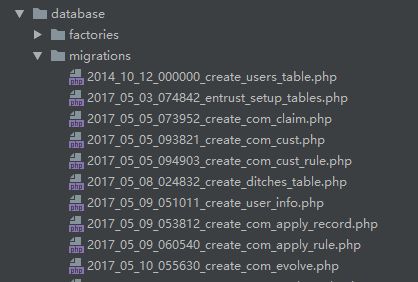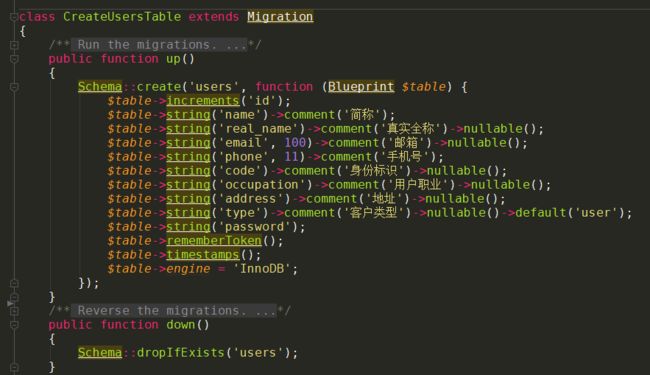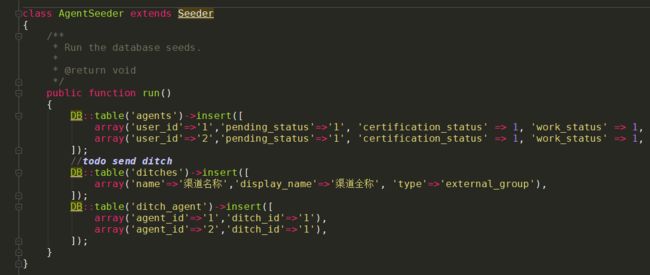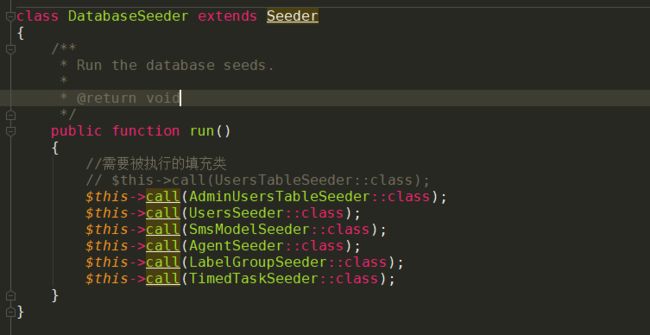使用过很多的PHP框架,当第一次接触laravel框架的数据库迁移功能,仿佛打开了一扇新大门。迁移就像数据库的版本控制,允许团队简单轻松的编辑并共享应用的数据库表结构,迁移通常和Laravel 的 schema 构建器结对从而可以很容易地构建应用的数据库表结构。
artisan 生成迁移命令:
php artisan make:migration create_users_table
php artisan make:migration create_users_table --create=users
php artisan make:migration add_votes_to_users_table --table=users
php artisan make:migration create_users_table --create=users --path=path
新的迁移位于 database/migrations 目录下,每个迁移文件名都包含时间戳从而允许 Laravel 判断其顺序。--table 和 --create 选项可以用于指定表名以及该迁移是否要创建一个新的数据表。如果你想要指定生成迁移的自定义输出路径,在执行 make:migration 命令时可以使用 --path 选项,提供的路径应该是相对于应用根目录的。
迁移文件实例:
运行迁移命令:
php artisan migrate 要运行应用中所有未执行的迁移
php artisan migrate --force 在生产环境中强制运行迁移
php artisan migrate:rollback 回滚迁移
php artisan migrate:rollback --step=5 回滚指定数目的迁移(回滚最后五条迁移)
php artisan migrate:reset 回滚所有的应用迁移
php artisan migrate:refresh 先回滚所有数据库迁移,然后运行 migrate 命令(重建整个数据库)
数据库填充:
迁移填充命令:
php artisan migrate:refresh --seed 先回滚所有数据库迁移,然后运行 migrate 命令,执行填充命令。(重建整个数据库)
php artisan migrate:refresh --step=5
迁移文件,数据表操作:
1.创建表 使用 create 方法创建表:
Schema::create('users', function ($table) { $table->increments('id'); });
2.检查表/列是否存在,可以使用 hasTable 和 hasColumn 方法检查表或列是否存在:
if (Schema::hasTable('users')) {}
if (Schema::hasColumn('users', 'email')) {}
3.连接 & 存储引擎,可以使用connection 方法:
Schema::connection('foo')->create('users', function ($table) { $table->increments('id');});
4.置表的存储引擎,在 Schema 构建器上设置 engine 属性:
Schema::create('users', function ($table) {$table->engine = 'InnoDB'; $table->increments('id');});
5.重命名,可以使用 rename 方法:
Schema::rename($from, $to);
6.删除,可以使用 drop 或 dropIfExists 方法:
Schema::drop('users');
Schema::dropIfExists('users');
迁移文件,数据列操作
创建数据列,使用 Schema 门面上的 table 方法,和 create 方法一样,table 方法接收两个参数:表名和获取用于添加列到表的 Blueprint 实例的闭包:
Schema::table('users', function ($table) {$table->string('email');});
可用的数据列类型
$table->bigIncrements('id');自增ID,类型为bigint
$table->bigInteger('votes');等同于数据库中的 BIGINT 类型
$table->binary('data');等同于数据库中的 BLOB 类型
$table->boolean('confirmed');等同于数据库中的 BOOLEAN 类型
$table->char('name', 4);等同于数据库中的 CHAR 类型
$table->date('created_at');等同于数据库中的 DATE 类型
$table->dateTime('created_at');等同于数据库中的 DATETIME 类型
$table->dateTimeTz('created_at');等同于数据库中的 DATETIME 类型(带时区)
$table->decimal('amount', 5, 2);等同于数据库中的 DECIMAL 类型,带一个精度和范围
$table->double('column', 15, 8);等同于数据库中的 DOUBLE 类型,带精度, 总共15位数字,小数点后8位
$table->enum('choices', ['foo', 'bar']);等同于数据库中的 ENUM 类型
$table->float('amount');等同于数据库中的 FLOAT 类型
$table->increments('id');数据库主键自增ID
$table->integer('votes');等同于数据库中的 INTEGER 类型
$table->ipAddress('visitor');等同于数据库中的 IP 地址
$table->json('options');等同于数据库中的 JSON 类型
$table->jsonb('options');等同于数据库中的 JSONB 类型
$table->longText('description');等同于数据库中的 LONGTEXT 类型
$table->macAddress('device');等同于数据库中的 MAC 地址
$table->mediumIncrements('id');自增ID,类型为无符号的 mediumint
$table->mediumInteger('numbers');等同于数据库中的 MEDIUMINT 类型
$table->mediumText('description');等同于数据库中的 MEDIUMTEXT 类型
$table->morphs('taggable');添加一个 INTEGER 类型的 taggable_id 列和一个 STRING 类型的 taggable_type 列
$table->nullableTimestamps();和 timestamps() 一样但允许 NULL 值
$table->rememberToken();添加一个 remember_token 列: VARCHAR(100) NULL
$table->smallIncrements('id');自增ID,类型为无符号的 smallint
$table->smallInteger('votes');等同于数据库中的 SMALLINT 类型
$table->softDeletes();新增一个 deleted_at 列用于软删除
$table->string('email');等同于数据库中的 VARCHAR 列
$table->string('name', 100);等同于数据库中的 VARCHAR,带一个长度
$table->text('description');等同于数据库中的 TEXT 类型
$table->time('sunrise');等同于数据库中的 TIME 类型
$table->timeTz('sunrise');等同于数据库中的 TIME 类型(带时区)
$table->tinyInteger('numbers');等同于数据库中的 TINYINT 类型
$table->timestamp('added_on');等同于数据库中的 TIMESTAMP 类型
$table->timestampTz('added_on');等同于数据库中的 TIMESTAMP 类型(带时区)
$table->timestamps();添加 created_at 和 updated_at 列
$table->timestampsTz();添加 created_at 和 updated_at 列(带时区)
$table->unsignedBigInteger('votes');等同于数据库中无符号的 BIGINT 类型
$table->unsignedInteger('votes');等同于数据库中无符号的 INT 类型
$table->unsignedMediumInteger('votes');等同于数据库中无符号的 MEDIUMINT 类型
$table->unsignedSmallInteger('votes');等同于数据库中无符号的 SMALLINT 类型
$table->unsignedTinyInteger('votes');等同于数据库中无符号的 TINYINT 类型
$table->uuid('id');等同于数据库的UUID
修改器描述
->after('column')将该列置于另一个列之后 (仅适用于MySQL)
->comment('my comment')添加注释信息
->default($value)指定列的默认值
->first()将该列置为表中第一个列 (仅适用于MySQL)
->nullable()允许该列的值为NULL
->storedAs($expression)创建一个存储生成列(只支持MySQL)
->unsigned()设置 integer 列为 UNSIGNED
->virtualAs($expression)创建一个虚拟生成列(只支持MySQL)
重命名列,要重命名一个列,可以使用表结构构建器上的renameColumn 方法,在重命名一个列之前,确保 doctrine/dbal 依赖已经添加到composer.json 文件并且已经运行了 composer update 命令:
Schema::table('users', function ($table) { $table->renameColumn('from', 'to');});
注:暂不支持 enum 类型的列的修改和重命名。
删除数据列,要删除一个列,使用 Schema 构建器上的dropColumn 方法,同样,在此之前,去报已经安装了 doctrine/dbal 依赖:
Schema::table('users', function ($table) {$table->dropColumn('votes');});
你可以传递列名数组到 dropColumn 方法从表中删除多个列:
Schema::table('users', function ($table) {$table->dropColumn(['votes', 'avatar', 'location']);});
注:SQLite数据库暂不支持在单个迁移中删除或修改多个列。
7、索引
创建索引
Schema 构建器支持多种类型的索引,首先,让我们看一个指定列值为唯一索引的例子。要创建索引,可以使用 unique 方法:
$table->string('email')->unique();
此外,你可以在定义列之后创建索引,例如:
$table->unique('email');
你甚至可以传递列名数组到索引方法来创建组合索引:
$table->index(['account_id', 'created_at']);
Laravel 会自动生成合理的索引名称,不过你可以传递第二个参数到该方法用于指定索引名称:
$table->index('email', 'my_index_name');
可用索引类型
命令描述
$table->primary('id');添加主键索引
$table->primary(['first', 'last']);添加混合索引
$table->unique('email');添加唯一索引
$table->unique('state', 'my_index_name');指定自定义索引名称
$table->unique(['first', 'last']);添加组合唯一索引
$table->index('state');添加普通索引
删除索引,要删除索引,必须指定索引名。
$table->dropPrimary('users_id_primary');从 “users”表中删除主键索引
$table->dropUnique('users_email_unique');从 “users”表中删除唯一索引
$table->dropIndex('geo_state_index');从 “geo”表中删除普通索引




